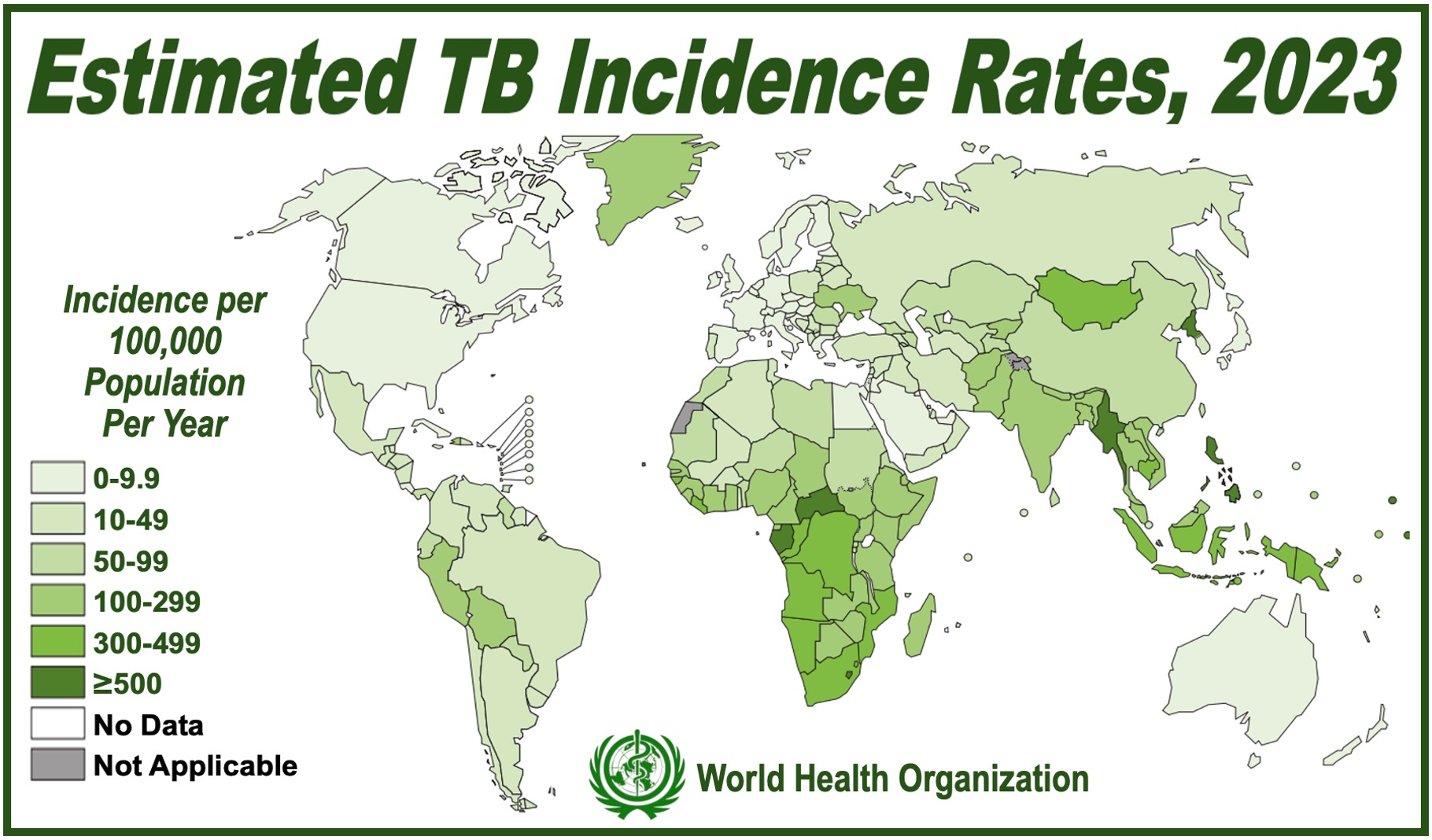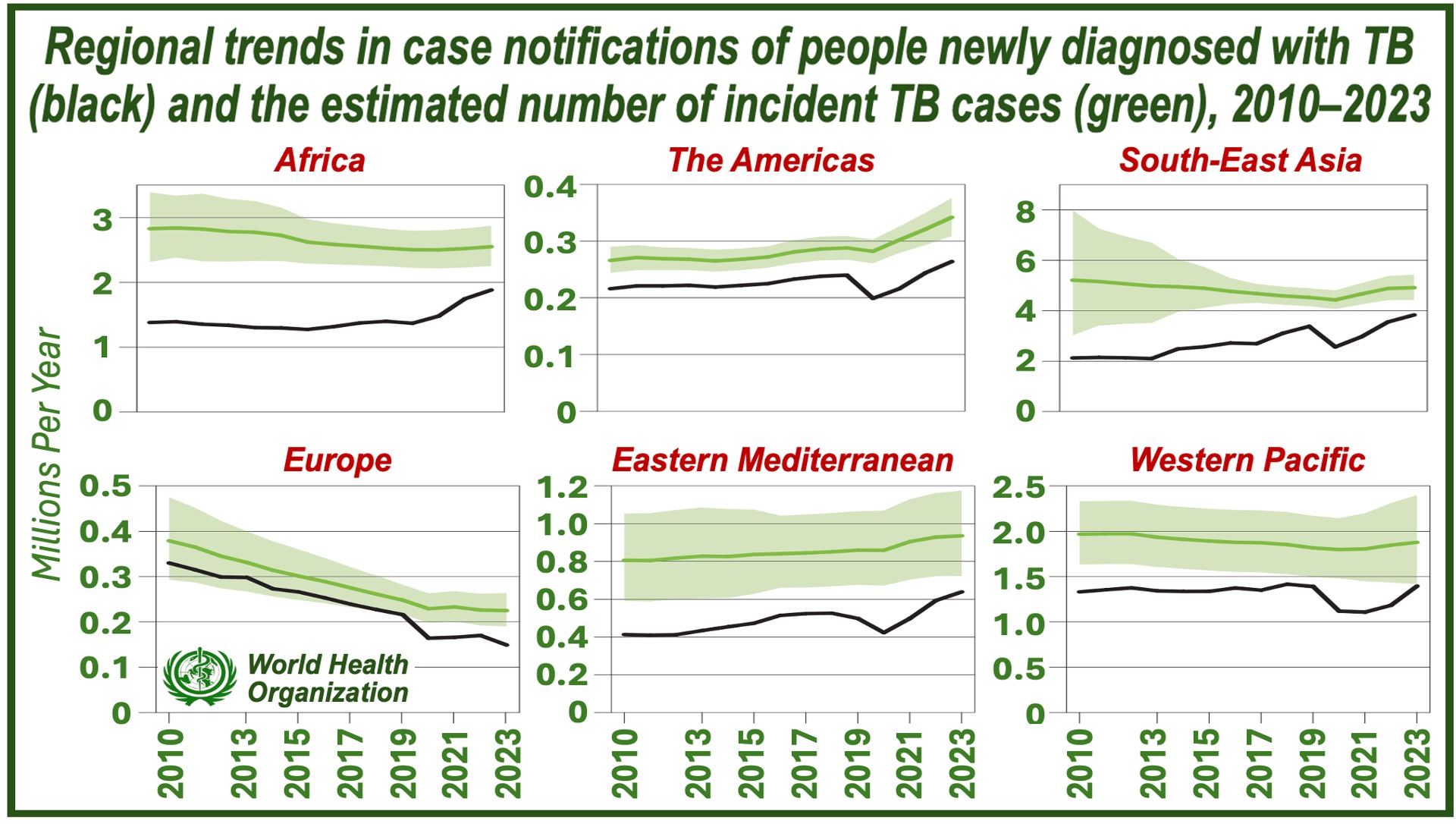According to the World Health Organization, tuberculosis (TB) surpassed COVID-19 as the world’s top infectious disease killer in 2023. Last year, approximately 8.2 million people were diagnosed with TB. This is the highest number since WHO started tracking the disease worldwide.
A total of 1.25 million people died from TB in 2023 – more than three times the number of COVID-19 deaths during the same period.
Tuberculosis is a bacterial infection that primarily affects the lungs and is spread through the air. Later in the article, we shall look at the disease in more detail.
Rise in Tuberculosis Cases and Global Impact
The number of TB cases is rising, especially in low- and middle-income countries. India, Indonesia, China, the Philippines, and Pakistan together accounted for more than half of all cases worldwide last year.
Even though tuberculosis is preventable and curable, it remains a serious public health threat in many parts of the world, especially in areas with limited healthcare resources.
The World Health Organization says that the impact of the COVID-19 pandemic on healthcare services was partly to blame for the increase in TB cases.
TB diagnosis and treatment were disrupted during the pandemic, leading to a sizable backlog of undiagnosed cases. Additionally, multidrug-resistant TB (MDR-TB) continues to pose a major challenge. Last year, only 44% of the estimated 400,000 MDR-TB cases were diagnosed and treated.
Dr. Tedros Adhanom Ghebreyesus, WHO Director-General, said the following:
“The fact that TB still kills and sickens so many people is an outrage, when we have the tools to prevent it, detect it and treat it. WHO urges all countries to make good on the concrete commitments they have made to expand the use of those tools, and to end TB.”

Key Challenges in Tuberculosis Control
The number of new TB cases has been rising. Experts say that this is due to several factors, including poverty, malnutrition, smoking, alcohol use, and diabetes.
The disease affects some of the world’s most vulnerable populations. Men account for 55% of cases, women for 33%, and children and young teens for 12%.
A major barrier to TB control is the cost of treatment. The expenses related to medical care, transportation, and lost income can be overwhelming for many patients. WHO points out that approximately half of TB-affected households are facing “catastrophic costs,” meaning their expenses exceed 20% of household income.
Funding Shortfalls and the Need for Global Action
Who’s Global Tuberculosis Report 2024 highlights a severe funding gap for TB prevention, diagnosis, and treatment.
Of the $22 billion target last year, only $5.7 billion was available, leaving a shortfall of $16.3 billion.
Funding for TB research also lags behind, with only one-fifth of the $5 billion annual target met.
This lack of investment slows the development of new diagnostics, drugs, rapid testing technologies, vaccines, data collection systems, and public health programs needed to fight TB effectively.
WHO is calling for global action to reverse the trend. It is urging countries to invest more in TB control measures and fulfil commitments made at the United Nations High-Level Meeting on TB.
Current funding and commitment levels are nowhere near enough to reduce the global TB burden and to prevent future deaths.

About Tuberculosis
Tuberculosis is a bacterial infection caused by Mycobacterium tuberculosis (M. tuberculosis). It primarily affects the lungs but is capable of spreading to other parts of the body.
It has been around for thousands of years. There is evidence of TB in human remains dating back to 7000 BC—about 9,000 years ago. Despite medical advancements, it remains a serious global health issue.
-
Transmission
You can catch TB if you inhale tiny airborne droplets expelled by an infected person’s cough or sneeze.
Most infections remain dormant (latent TB) and are not contagious. However, they can reactivate if the person’s immune system is weakened by, for example, aging, HIV infection, diabetes, malnutrition, certain medications, or treatments like chemotherapy.

-
Signs and Symptoms
When TB becomes active, symptoms include a persistent cough, fever, night sweats, weight loss, and fatigue.
If left untreated, the patient’s lungs may become damaged, as well as other organs, potentially leading to life-threatening complications.
-
Diagnosis
Your doctor will listen to your breathing with a stethoscope, check for swollen lymph nodes, and ask you about your symptoms.
If they suspect TB or you were likely exposed to a person with active TB disease, they will order a skin test, blood test, imaging scan, and a sputum test. Some doctors may also order a urine test, cerebrospinal fluid test, and a breath test.
-
Treatment
You will be prescribed a long course of antibiotics, typically lasting six months. Although treatment is effective, you must complete the entire course to prevent drug-resistant strains from developing.
Drug-resistant TB can be more difficult and costly to treat, requiring specialized medications and a longer treatment period.
The Mayo Clinic says the following regarding completing the treatment as instructed:
“It is important to take every dose as instructed. And you must complete the full course of treatment. This is important for killing the bacteria in your body and preventing new drug-resistant bacteria.”
-
Outlook – Prognosis
If you are diagnosed and treated early on, your prognosis is good, that is, you should make a full recovery. Tuberculosis that is left untreated can become fatal.
Young children, older people, and those with weakened immune systems, such as people living with HIV, are at higher risk of complications.
BCG Vaccine
There is a vaccine that protects against TB. It is called the BCG vaccine, and was developed in the 1920s. It was created by French scientists Albert Calmette and Camille Guérin. The vaccine’s name, BCG, stands for Bacillus Calmette-Guérin, in honor of its creators. “Bacillus” means rod-shaped bacterium.
The vaccine contains a live, weakened bacterium that triggers an immune response against TB in humans, thus providing protection from the disease. Its effectiveness typically lasts about 10-15 years but varies from person to person.
The UK’s National Health Service advises the following people to take the BCG vaccine:
- Adults up to 35 years of age who are spending over 3 months in a country where tuberculosis is common.
- Babies who live in areas where TB is more prevalent.
- Healthcare workers and others who work with patients who have TB.
- Babies and children who live with an infected person.
- Babies and children who come from a country where TB is more common.
- Babies and children whose parents or grandparents come from a country where TB is more common.
Final Thoughts
Tuberculosis is still one of the world’s most pressing public health challenges, responsible for over one million deaths each year globally, despite being preventable and treatable.
It is now the top infectious disease killer worldwide. There is an urgent need for global action, funding, and commitment to reduce its impact, according to WHO.
If we improve access to diagnostic tools, treatment, and vaccines, we can work towards a future where TB no longer claims so many lives each year.
